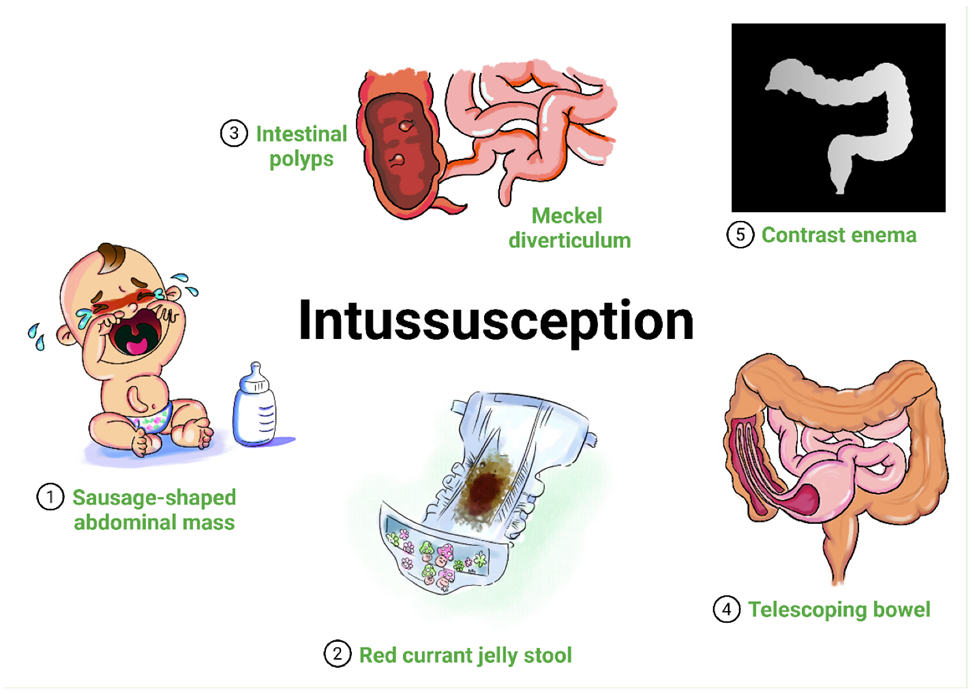The nurse is preparing to care for a child with a diagnosis of intussusception. The nurse reviews the child's record and expects to note which sign of this disorder documented?
Ribbon-like stools
Profuse projectile vomiting
Bright red blood and mucus in the stools
Watery diarrhea
The Correct Answer is C
A. Ribbon-like stools
Explanation: Ribbon-like or pencil-thin stools are associated with conditions affecting the rectum, such as colorectal cancer, but they are not a typical sign of intussusception.
B. Profuse projectile vomiting
Explanation: Profuse projectile vomiting is not a typical sign of intussusception. Vomiting may occur, but it is not the primary characteristic feature.
C. Bright red blood and mucus in the stools
Explanation:
Intussusception is a condition in which one part of the intestine slides into another, causing a blockage. One of the classic signs of intussusception is the presence of "currant jelly" stools, which are characterized by a mixture of bright red blood and mucus in the stools. This occurs due to the compression of the blood vessels in the intestine, leading to bleeding and mucosal discharge.
D. Watery diarrhea
Explanation: Watery diarrhea is not a typical sign of intussusception. The condition is more commonly associated with abdominal pain, vomiting, and the characteristic "currant jelly" stools.

Nursing Test Bank
Naxlex Comprehensive Predictor Exams
Related Questions
Correct Answer is B
Explanation
A. "Has your child been exposed to anyone with chicken pox?"
While chickenpox is caused by a different virus (varicella-zoster virus) and is not directly linked to rheumatic fever, the nurse might inquire about exposure to contagious illnesses as a general part of the assessment.
B. "Has any family member had a sore throat within the past few weeks?"
This question is relevant because rheumatic fever often follows an untreated or inadequately treated group A streptococcal infection, such as strep throat. A sore throat in a family member could indicate the presence of streptococcal infection, which is a crucial factor in the development of rheumatic fever.
C. "Has any family member had a gastrointestinal disorder in the past few weeks?"
Gastrointestinal disorders are not directly associated with the development of rheumatic fever. However, a comprehensive medical history might include questions about recent illnesses to understand the overall health context.
D. "Has your child had difficulty urinating?"
Difficulty urinating is not a typical symptom or risk factor associated with rheumatic fever. This symptom would likely prompt investigation into other potential issues but is not specifically related to rheumatic fever.
Correct Answer is D
Explanation
A. Sausage-shaped mass palpated in the upper right abdominal quadrant.
Explanation: A sausage-shaped mass in the upper right abdominal quadrant is more indicative of Hirschsprung's disease, not imperforate anus. In Hirschsprung's disease, there is a lack of ganglion cells in the rectum, leading to obstruction and a palpable mass.
B. The passage of currant jelly-like stools.
Explanation: The passage of currant jelly-like stools is characteristic of intussusception, a condition where one portion of the intestine telescopes into another. It is not associated with imperforate anus.
C. Bile-stained fecal emesis.
Explanation: Bile-stained fecal emesis suggests a possible intestinal obstruction or other gastrointestinal issue, but it is not a specific manifestation of imperforate anus. Imperforate anus is primarily characterized by the absence of a normal anal opening.
D. Failure to pass meconium stool in the first 24 hours after birth.
Explanation:
Imperforate anus refers to a congenital condition in which the opening to the anus is absent or improperly formed. One of the clinical manifestations is the failure to pass meconium stool within the first 24 hours after birth. Meconium is the thick, sticky, greenish-black substance that constitutes a newborn's first stools. The absence of meconium passage suggests a potential obstruction.
Whether you are a student looking to ace your exams or a practicing nurse seeking to enhance your expertise , our nursing education contents will empower you with the confidence and competence to make a difference in the lives of patients and become a respected leader in the healthcare field.
Visit Naxlex, invest in your future and unlock endless possibilities with our unparalleled nursing education contents today
Report Wrong Answer on the Current Question
Do you disagree with the answer? If yes, what is your expected answer? Explain.
Kindly be descriptive with the issue you are facing.
